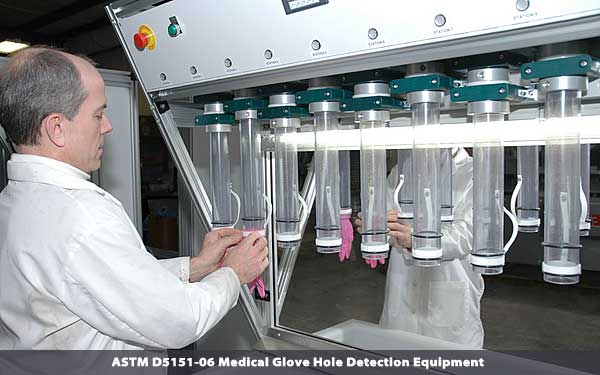Test/Inspection Equipment
Thin walled dip molded products are often subjected to testing for the presence of imperfections in the film referred to as pinholes. Three of the most common methods are water, air and conductive testing. Common products tested for pinholes are medical exam gloves, condoms and medical respiratory bags. DipTech Systems offers testing equipment for all methods as well as a variety of products including:
• Glove Water Leak Test Stands
• Condom Conductivity Test Systems
• Condom Water Leak Test Stands
• Glove Inflationary Test Systems
• Bag Inflationary Test Systems
Contact DipTech Systems® to review the Test & Inspection equipment required for your project.
The FDA requires the testing of medical exam gloves for pinholes. A standard industry accepted method for batch testing is a water test. Each exam glove is filled with 1000 ml of water and examined for leaks. DipTech Systems® has worked closely with the FDA’s Winchester Engineering & Analytical Center (WEAC) regional laboratories as well as the Pacific Regional laboratories in the development of an automated glove water leak test stand. We are pleased to have been selected by the FDA to provide multiple test stands to each of their major east and west coast testing facilities.
Air inflation test tables are often utilized to inspect products such as surgeon’s gloves. The table individually inflates the glove under low pressure and provides and internal light source to aid the technician in inspecting common areas for pin holes such as the finger crotches.

Similarly, air inflation systems that test for the change in physical shape or characteristic of the product to detect leakage caused by pin holes are utilized. Products such as respiratory rebreather bags and gloves are tested by inflating a defined volume and pressure of air into the product and allowing the product to dwell for a period of time to determine if a measurable change in the product envelope dimensions can be detected. By integrating various sensors to the system, the testing and material handling can be fully automated allowing good product to be automatically transferred to downstream operations such as packaging with rejected product segregated for disposal.
The emergence of the AIDS pandemic focused an even higher level of attention on the condom industry as well. In the late 1980s, standards organizations began to formulate testing methods and criteria for gloves and condoms. These standards were adopted by governing agencies such as the FDA and replaced the previously self-imposed tests that manufacturers utilized to control quality. The FDA currently uses the ASTM standard for condoms as a basis for audits of manufacturers. DipTech Systems supplies equipment for the leakage and burst testing portion of the required testing.
Both dry and wet leakage testing equipment is offered. The dry method involves placing the condom on a conductive mandrel and inducing an electrical charge across the film. If current is passed through the film to the mandrel through a hole in the film the condom is rejected and automatically deposited into a reject bin. A condom that passes the test is rolled up and conveyed for downstream processing.
The wet test involves taking a sample of several condoms from the manufacturing lots and calculating the percentage that passed the test. A defined volume of water is introduced into a vertically hanging condom. The condom is then removed and rolled on a table surface, with the water contained inside the condom. The technician then visually inspects for tiny amounts of water leaking from pin holes in the film of the condom.
Air burst testing inflates the entire condom like a balloon, stretching the film wall until it bursts. The test monitors and measures the volume of air induced to the condom at the point of failure as well as the pressure inside the condom.
HAVE A QUESTION?
WE ARE HERE TO HELP!

